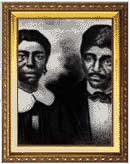
32. From Uneasy Peace to Bitter Conflict

Dred and Harriet Scott were taken through free territory on their way to St. Louis. Their court battle for freedom added another facet to the slavery issue.
Between 1856 and 1860, America would see a breakdown in many of its political processes that had developed over the last eight decades. The great compromisers of the early 19th century — Daniel Webster, Henry Clay and John Calhoun — were gone, and their leadership in avoiding disunion were gone as well. Forces on the extremes were becoming more and more powerful, reducing the influence of moderates and crippling the spirit of reconciliation. Front and center was the issue of slavery. Could the country be saved, or was it on an irrevocable path toward disunion?
The Congress and the Presidents of the past decade had failed to resolve the burning issue of slavery in the territories. Could the Supreme Court, the highest law in the land, put the issue to rest? Politicians and the American public hoped it could determine some long term framework for settlement of the slavery issue. An opportunity was presented when the Dred Scott case reached the High Court. As a slave having lived in a free territory, was he now free when he returned to a slave state? No. And more — neither a state nor Congress had the right to outlaw slavery.

John Brown and his men hid inside this engine house for cover, but were captured there by Federal troops.
The Dred Scott decision was unacceptable in the north. This prompted a young lawyer from Illinois to return to politics, seeking Stephen Douglas's seat in Congress — he was Abraham Lincoln. A series of debates between the two foreshadowed the issues of the election 1860.
John Brown returned. He organized a daring attack on slavery by attempting to incite a mass uprising of slaves, at Harper's Ferry, Virginia. While he failed in his effort to cause a slave rebellion, he succeeded in causing an insurrection of conscience in the north as well as grave misgivings in the south about its future in the Union.
The results of these events and the forces that caused them became hot spots in the cauldron of electoral politics. The north could never accept a President who planned to protect or extend slavery. The south would never accept a President who refused to do so. The nomination of candidates and the election of the President in 1860 were among the most divisive events in the history of this nation. Abraham Lincoln was President, and within weeks, 7 states left the Union to form the Confederate States of America.




